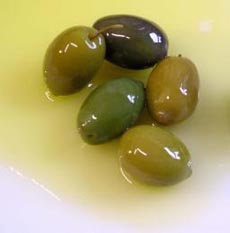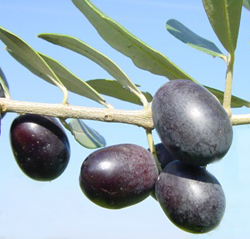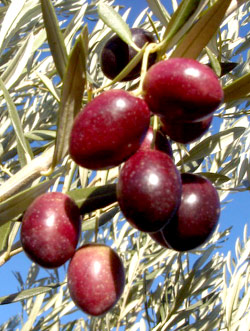

Olive oil is pressed from the fresh-picked fruit of the olive tree. Photo by Iliana | SXC.
November 2005
Updated June 2009
|
 |
Olive Oil & Olive Glossary
Page 6: Terms With L & M
This is Page 6 of the Olive Oil & Olive Glossary. If you think we should consider terms or definitions than those we have provided, use the Contact Us links on this page. Also read our article, Flavors and Aromas of Olive Oil. Visit our collection of 60+ food glossaries to learn more about other food products.
You can click on the letter of the alphabet in the bar below to get to a term
without having to scroll manually.
a b c d e f g h i j k l m n o p q r s t u v w x y z
This glossary is protected by copyright and cannot be reproduced in whole or part.
LAMPATE VIRGIN OLIVE OIL
Defective olive oil that is high in natural acid (3.3% or more), has poor flavor, or an unpleasant odor. It is not fit for human consumption without additional processing, after which it is known as refined oil and can be sold simply as olive oil.
LATE HARVEST OLIVE OIL -or- WINTER HARVEST OLIVE OIL
IOOC Definition: The fruit is picked black and ripe. The fruit may have a little more oil but it is risky because waiting longer into the winter increases the risk the fruit will be damaged by frost. Late harvest or “winter” fruit is more ripe; like other ripe fruit it has a light, mellow taste with little bitterness and more floral flavors. Flavor notes include peach, melon, perfumy, apple, banana, buttery, fruity, rotund, soave and sweet.
LECCINO OLIVE
 One of the main Italian cultivars, along with Carolea and Frantoio—some call it the second most important oil variety in Italy, after the Frantoio. The olive has a mild, sweet flavor and produces a fresh-tasting oil, often used in blends—it is one of the four olives used in the “Tuscan blend,” along with the Frantoio, the Moraiolo and the Pendolino. Its oil has a slight fruitiness, very slight bitterness and pungency. Like Frantoio, it has a sweetish flavor. It’s a high-yield, tolerant (to weather) olive that is also enjoyed as a table olive. The oil has average stability. One of the main Italian cultivars, along with Carolea and Frantoio—some call it the second most important oil variety in Italy, after the Frantoio. The olive has a mild, sweet flavor and produces a fresh-tasting oil, often used in blends—it is one of the four olives used in the “Tuscan blend,” along with the Frantoio, the Moraiolo and the Pendolino. Its oil has a slight fruitiness, very slight bitterness and pungency. Like Frantoio, it has a sweetish flavor. It’s a high-yield, tolerant (to weather) olive that is also enjoyed as a table olive. The oil has average stability.
You can buy the tree at Olive-Trees.net.
LIGHT OLIVE OIL -or- LITE OLIVE OIL
IOOC Definition: In the U.S., flavorless and often low quality (refined) oil is sold as “lite” or “light” oil for a premium price. The “light” designation refers to flavor, not caloric content, as all olive oil has the same amount of calories (120 calories per tablespoon). There is no official industry or government definition of lite or light.
LINOLEIC ACID
Not to be confused with the linolenic acid, linoleic acid is an unsaturated n-3 essential fatty acid, part of the omega-6 fatty acids. It is abundant in many vegetable oils, especially safflower and sunflower oils. It is essential for all mammals; deficiency of omega-6 fatty acids include dry hair, hair loss and poor wound healing.
LINOLENIC ACID
α-linolenic acid is an n-3 essential fatty acid, so called because it cannot be produced within the body and must be acquired through diet. It is an organic compound found in many common vegetable oils including canola (rapeseed), flaxseed, hemp, soybean and walnut. It is also found in chia, kiwi, lingonberry, purslane, sea buckthorn (seaberry) and shiso (perilla). Most seeds and seed oils are much richer in an n−6 fatty acid, linoleic acid. It is the linolenic acid that has enabled olive oil producers to claim heart-healthy benefits: Two tablespoons per day have been shown in clinical studies to have a beneficial effect in reducing coronary disease.
LUCQUES OLIVE
The lucques olive originated in the south of France. It is green and elongated like the picholine, but larger in size. Like the picholine, the flavor is mild and nutty.
MANZANILLO OLIVE
 A Spanish cultivar, this medium-size olive (pronounced man-za-NEE-yo) is typically served as a table olive because of its low oil content (according to Olive-Trees.net, it is the world’s number one table olive). For many years, green manzanillo olives stuffed with pimento have been a chief export, gracing martinis and antipastos. Unpitted, this olive, with its firm meat and a tangy taste, is a great cooking olive as well. However, artisan oil producers are pressing this olive for oil because of its superior qualities, which an include a delicate herb and floral nose, a green banana flavor on the mid-palate and a long, grassy finish. A Spanish cultivar, this medium-size olive (pronounced man-za-NEE-yo) is typically served as a table olive because of its low oil content (according to Olive-Trees.net, it is the world’s number one table olive). For many years, green manzanillo olives stuffed with pimento have been a chief export, gracing martinis and antipastos. Unpitted, this olive, with its firm meat and a tangy taste, is a great cooking olive as well. However, artisan oil producers are pressing this olive for oil because of its superior qualities, which an include a delicate herb and floral nose, a green banana flavor on the mid-palate and a long, grassy finish.
You can buy the tree at Olive-Trees.net.
MEAT
The flesh of the olive.
MILD OLIVE OIL
Processed olive oil that is lighter in flavor. See also light olive oil.
MISSION OLIVE
A black olive, the cultivar was bred in the 21 Franciscan missions of California, and is a widely-grown olive throughout California (the missions were located from San Diego in the south to Sonoma in the north). The medium sized oval fruit has a deep purple that changes to jet black when ripe. Principally used for table consumption, it is also made into artisan oil, which has a good level of olive fruitiness with hints of green apple, notes of almond and an overall sweet sensation. The mouthfeel is dense, owing to the low content of linolenic acid. The oil has a medium-to-low stability.
MORAIOLO OLIVE
The Moraiolo olive is usually cultivated alongside the Frantoio for blending (the two join the Leccino and the Pendolino in the classic “Tuscan blend”). It has similar qualities to the Frantoio: good fruitiness, green apple and almond notes and slight bitter and pungent qualities that are balanced with a sweet sensation in the mouth. Like the Frantoio, it is slightly astringent and has a grassy aroma. The Moraiolo has a more robust flavor than the more refined Frantoio, ripens earlier in the season and is hardier, with good tolerance to wind and adverse weather conditions. However, the oil has low stability, i.e., a tendency to go rancid quicker than other oils.
Continue To Next Page: Terms With O
Go To The Article Index Above
Lifestyle Direct, Inc. All rights reserved. Images are the copyright of their individual owners.

|





 One of the main Italian cultivars, along with Carolea and Frantoio—some call it the second most important oil variety in Italy, after the Frantoio. The olive has a mild, sweet flavor and produces a fresh-tasting oil, often used in blends—it is one of the four olives used in the “Tuscan blend,” along with the Frantoio, the Moraiolo and the Pendolino. Its oil has a slight fruitiness, very slight bitterness and pungency. Like Frantoio, it has a sweetish flavor. It’s a high-yield, tolerant (to weather) olive that is also enjoyed as a table olive. The oil has average stability.
One of the main Italian cultivars, along with Carolea and Frantoio—some call it the second most important oil variety in Italy, after the Frantoio. The olive has a mild, sweet flavor and produces a fresh-tasting oil, often used in blends—it is one of the four olives used in the “Tuscan blend,” along with the Frantoio, the Moraiolo and the Pendolino. Its oil has a slight fruitiness, very slight bitterness and pungency. Like Frantoio, it has a sweetish flavor. It’s a high-yield, tolerant (to weather) olive that is also enjoyed as a table olive. The oil has average stability.  A Spanish cultivar, this medium-size olive (pronounced man-za-NEE-yo) is typically served as a table olive because of its low oil content (according to Olive-Trees.net, it is the world’s number one table olive). For many years, green manzanillo olives stuffed with pimento have been a chief export, gracing martinis and antipastos. Unpitted, this olive, with its firm meat and a tangy taste, is a great cooking olive as well. However, artisan oil producers are pressing this olive for oil because of its superior qualities, which an include a delicate herb and floral nose, a green banana flavor on the mid-palate and a long, grassy finish.
A Spanish cultivar, this medium-size olive (pronounced man-za-NEE-yo) is typically served as a table olive because of its low oil content (according to Olive-Trees.net, it is the world’s number one table olive). For many years, green manzanillo olives stuffed with pimento have been a chief export, gracing martinis and antipastos. Unpitted, this olive, with its firm meat and a tangy taste, is a great cooking olive as well. However, artisan oil producers are pressing this olive for oil because of its superior qualities, which an include a delicate herb and floral nose, a green banana flavor on the mid-palate and a long, grassy finish.